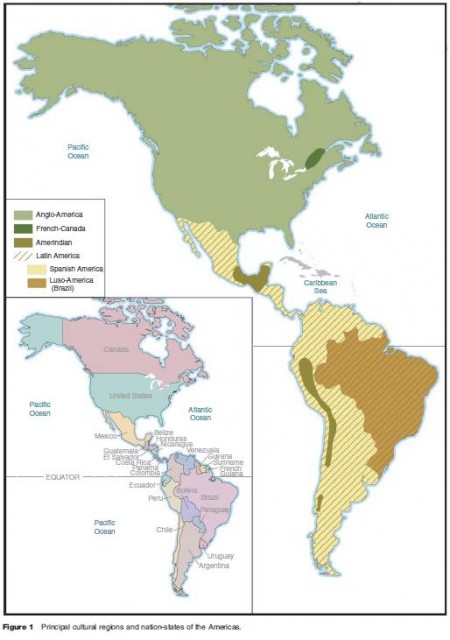Regional Perspectives
Conceptually, the Americas can be subdivided into subregions using distinct criteria. From an environmental or geographical perspective, it is often divided into three macro divisions – the continental landmasses of North America and South America, and the small narrow landbridge, Central America, which joins the two continents. The human geography of the region is better understood and conceptualized differently. At the broadest scale, two principal cultural regions can be identified – Anglo America and Latin America. Anglo America corresponds essentially to those countries, the United States and Canada, which trace their colonial history and their principal cultural heritage and dominant language to England (Great Britain). The regional delimitation of Latin America is also determined from the region's colonial heritage, and pertains to those countries which were colonies of Spain or Portugal. 'Iberoamerica' is also a term used to describe the same region. The term originates from the fact that in Europe, both Spain and Portugal occupy the Iberian Peninsula. Latin America is further subdivided among those areas which experienced Spanish colonial rule, Spanish America or Hispano America, and those areas that were under the colonial control of the Portuguese, Luso America.
The contemporary human geography of these macroregions, Anglo America and Latin America, is by no means homogenous. The French speaking region of Canada, Quebec, along the St. Lawrence River, is a notable anomaly in the Anglo America realm. Francophone Quebec is home to approximately 7.5 million Canadians and comprises nearly 24% of Canada's total population. Quebec has a distinct culture within the greater Canadian society and separatist sentiment has been strong at times. In the 1960s, Quebec enacted provincial laws to protect and strengthen its identity as a separate and unique culture. The official language is French and nearly all place names, business activities, and education are conducted in French. With significant political clout and the Canada's second largest provincial economy, Quebec, has used its power to secure its identity as a distinct 'nation' within the Canadian state. Other French speaking enclaves are found in Latin America as well, most notably Haiti and French Guiana, an overseas territory of France (Figure 1).

Contemporary migration streams, largely from Mexico and other Latin American countries into the US's southwest and its major urban areas, are also creating anomalies in Anglo America's cultural landscape.
Amerindian peoples maintain distinct cultural identities in rural settlements and reservations across the United States and Canada. Many of these extant groups are few in number and geographically restricted, but others like the Navajo peoples in the southwestern United States, number in the 100 000 s and occupy large geographical areas. In Latin America, the survival of Amerindian peoples as well as their cultures and languages represent the most significant exceptions to the region's cultural homogeneity. These Amerindian cultures are most significant, and number in the millions in three or four principal areas in Latin America. These include the Nahuatl and Maya in southern Mexico and northern Central American, the Quechua and Aymara in the Andes, Guarani peoples in the Amazon Basin and Paraguay, and Mapuche in southern Chile. Other cultural anomalies exist in Latin America, but generally these are small and geographically and numerically insignificant. Despite these exceptions, when compared to many other world regions, especially at a continental scale, the Americas exhibit a strong degree of cultural and social homogeneity in terms of human geography.
African immigration, most of it forced through the institution of slavery between the sixteenth and nineteenth centuries, has had a profound impact on the human geography of the Americas. At present, peoples of African descent represent a substantial proportion of the population in Brazil (30–40%) and in the United States (close to 15%). Populations are also locally dense along the Pacific coastal areas of northern South America and on the margins of the Caribbean in both South and Central America. Regionally distinct Afro American cultures are important in Brazil, the United States, and other countries with significant populations. Their cultural contributions are especially notable in music (e.g., blues and jazz), cuisine, and religious beliefs and practices (e.g., candomble in Brazil). All told, peoples of African descent account for approximately 150 million of the inhabitants of the Americas (excluding the Caribbean) – nearly 20% of the region's total population.
- Americas
- Few Examples of Territorial Development Policies
- The Five Great Dilemmas of Territorial Development
- First Experiments
- Which Scientific Status for Territorial Development?
- What Is Amenagement du Territoire or Territorial Development?
- Amenagement du Territoire: Territorial Development
- Critical Contemporary Aid Debates
- Humanitarian Aid